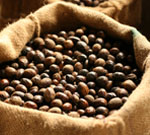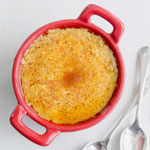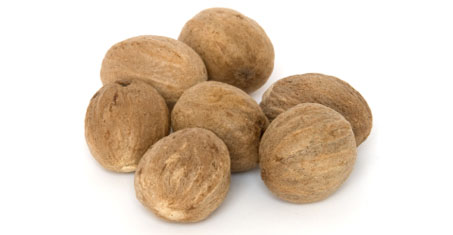What Is Nutmeg?

Nutmeg is actually the hard inner seed found inside the tropical fruit of a nutmeg tree, and it has one of the most unique and recognizable flavours of all spices. The seeds are light brown on the outside, oblong-shaped, and about an inch long. Inside, there are densely packed layers of starchy tissue and fragrant oil. It is warm and woody with hints of pine and clove, very similar to mace, which is part of the same fruit.
Nutmeg Plant and Cultivation

Deep, well drained, loam and sandy clay loam soils rich in organic matter are preferable. Soils with high water-table or liable to water logging are unsuitable. The seedlings are field planted at the beginning of the rainy season. In Nutmeg, there are separate male and female trees but the sex of the trees can be identified only after flowering. In general, about 50% of seedlings will be males. Therefore, the initial spacing may be about 6 m x 6 m and after flowering, they may be thinned out. Male trees do not fruit but are essential for pollination, for which 1 male to 10 female trees is adequate. Plant requires well distributed rainfall of 1,500-2,500 mm. In areas with a pronounced dry spell or sandy soils, the annual rainfall should be higher. The annual average temperature should be 20-30°C without much seasonal or diurnal variation. Persistent strong winds are harmful for the growth of plant. Sheltered valleys and leeward slopes are suitable for cultivate nutmeg. Plant can be grown at elevation up to about 600m in the wet zone. Shade is essential during the first 2-3 years of growth. Thereafter full exposure to sunlight is beneficial.
Nutmeg Description

Nutmeg plant is a spreading evergreen tree reaches up to 15-20 m height. The leaves are alternate, dark green, pinnatinerved. Flowers are generally unisexual and dioecious. However, bisexual flowers of varying sexual composition can also be found. Occasional trees with male and female flowers are also seen in the plantations. Fruits are fleshy drupes, broadly pyriform, drooping with a circumferential longitudinal ridge. Fruit colour turns into yellow during the ripening and the pericarp splits into 2 halves exposing purplish-brown, shiny seed surrounded by a net like red aril. Nutmeg tree yield two spices, nutmeg, which is the kernel of the seed and mace, which is the net-like crimson colored leathery out growth (aril) covering the shell of the seed.
Uses of Nutmeg

Nutmeg is used in both Western and Chinese herbal medicine. It is most popular as a spice in food and drinks, and is also used in cosmetics and soaps. Nutmeg oil is used in perfumes and ointments. In ancient Greece and Rome, where nutmeg was rare and expensive, people thought it stimulated the brain.
10 Health Benefits of Nutmeg
1 - Appetite & Digestion - For people suffering from a lack of appetite, nutmeg may help. It can also relieve gastrointestinal distress such as bloating by removing excess gas from the body.
2 - Leukemia - This same active ingredient, methanolic, it may also fight against certain leukemia cells.
3 - Liver & Kidneys - It's believed by some that nutmeg removes toxins that can build up in both areas, which occurs in both organs. Furthermore, nutmeg can help remove stubborn kidney stones, allowing you to pass them naturally.
4 - Brain Health - Nutmeg can be taken to stimulate the brain and to ward off stress and lack of energy. Nutmeg ingredient myristicin can also be effective against Alzheimer's and other memory-related conditions.
5 - Pain & Inflammation - The Chinese commonly included nutmeg in medicine for patients who were suffering from pain or inflammation. Nutmeg is currently used for a variety of pain, from general aches to arthritis. Some practitioners use the essential oil for rubbing on joints or other parts of the body that are experiencing pain.
6 - For Healthy And Glowing Skin - You can get a healthy and smooth skin with the use of nutmeg. The oil extract of nutmeg is used for making lotions, scrubs and cream. It is an ideal ingredient to enhance the facial beauty.
7 - Removes And Heals Acne - You can make home-made natural scrubs using powdered orange lentil and nutmeg. These scrubs work amazingly when it comes to removing blackheads.
8 - Anti oxidant properties - Nutmegs have antioxidants that are very useful in smooth functioning of the body. Nutmegs provide antioxidants, which prevent free radical formation, capable of triggering unwanted reactions in the body. These reactions may lead to many serious compound formations and may even turn out to be cancerous.
9 - For Shiny And Healthy Hair - Nutmeg oil can be used for hair care. It helps in quick hair growth and adds a lustrous shine. This essential oil is used in various hair products and has numerous advantages.
10 - Reduces Hair Fall - Nutmeg works effectively to tone your hair. It also increases blood circulation in the scalp and helps hair growth. Keeping the hair shiny and silky, it adds volume to the hair.
Producing Countries of Nutmeg

World production of nutmeg is estimated to average between 10,000 and 12,000 tonnes per year, with annual world demand estimated at 9,000 tonnes. Indonesia and Grenada dominate production and exports of both products, with world market shares of 75% and 20%, respectively. Other producers include India, Malaysia (especially Penang, where the trees grow wild within untamed areas), Papua New Guinea, Sri Lanka, and Caribbean islands, such as St. Vincent.
Consuming Countries of Nutmeg

The main import markets of nutmeg are the European Community, the United States, Japan, and India. United States, accounting for around 50% of total global imports, followed by the United Kingdom with approximately 10%. Singapore and the Netherlands are major re-exporters. Grenada produces the West Indian variety which is milder in flavor and lighter in colour. International trade in nutmegs is either of the East Indian variety or the West Indian variety, with a negligible quantity of wild 'Bombay' nutmegs imported by the United States.
Recipe for Beverages with Nutmeg
Eggnog

Ingredients: A: 4 egg yolks B: 2 cups of milk C: 1 cup of cream D: ½ cup of sugar E: 1 teaspoon of vanilla extract F: 1 teaspoon of freshly grated nutmeg G: 2 whole cloves H: Pinch of cinnamon I: (Adult option – 2 tablespoons of your favorite bourbon)
Preparation MethodA: Mix the egg yolks and slowly add the sugar until light and fluffy. B: In a separate pan combine the cloves, cinnamon and milk until simmering. C: Slowly add the milk mixture into the egg mixture whisking constantly. Then pour back into the pan and heat on a medium heat, stirring the mixture until it begins to thicken. D: Once suitably thickened, remove from the heat and stir in the cream. Strain the mixture to remove the cloves and let it cool. Once cooled, stir in the nutmeg and vanilla extract (add the bourbon now if you like).
Recipe for Cooking with Nutmeg
Kedgeree

Ingredients: A: ½ onion, finely chopped B: 55g/2oz butter C: 300g/10½oz basmati rice D: 1 tsp madras curry powder E: freshly grated nutmeg F: 200ml/7fl oz milk G: 110ml/4fl oz double cream H: 300g/10½oz naturally smoked haddock I: sea salt and cracked black pepper J: small bunch parsley, chopped K: 3 hard-boiled eggs, shelled and halved L: good pinch cayenne and freshly ground nutmeg M: knob of butter N: wedges of lemon
Preparation MethodA: Cook the onion gently in the butter for a few minutes, then add the rice. B: Continue cooking gently and stirring, adding the curry powder and nutmeg. After a few minutes, add the milk, cream and 250ml/9fl oz water. C: When the mixture begins to simmer, add the fish and continue simmering, stirring occasionally until the rice is cooked. (You may need to add a little water if the mixture becomes dry.) D: Season, add the parsley and stir. Add the eggs and garnish with cayenne and nutmeg if using. Serve topped with a knob of butter and wedges of lemon.
Recipe for Dessert with Nutmeg
Steamed Nutmeg Flan

Ingredients: A: 1½ cups (375 ml) whole milk B: ½ cup half and half (10% cream) or heavy cream C: 3 eggs D: ½ cup sugar, divided E: ½ nutmeg F: ½ cup water, divided
Preparation MethodA: Place the milk and cream in a large bowl, and stir in ¼ cup sugar. Whisk gently, until the sugar dissolves. Add the eggs, and beat until creamy. B: Grate about 1 teaspoon of fresh nutmeg into this mixture, and whisk well. Pour into a heatproof glass pie dish (or into 4 ramekins). C: Place a heatproof trivet in a large pot, and place the pie dish or ramekins on top. Gently pour in enough boiling water, so it just touches the bottom of the pie dish. Cover the pot with a tight fitting lid, and steam the flan for 30 minutes, until it is set, but with a wobbly middle. D: While the flan is steaming, make the caramel syrup. Place the remaining sugar in a heavy based pan, and gently sprinkle over the ¼ cup water. Place on a medium heat, and simmer gently until the sugar melts into a sticky golden brown caramel (watch it carefully and don't let it burn). Take off the heat and stir in the remaining water, until you have a thin, caramelly syrup. E: When the flan is done, gently run a sharp knife around the edges. Pour in the caramel syrup around the edges, so the flan is soaked in the syrup. F: Serve the flan warm, at room temperature or chilled

